Welcome - Dickinson Lab
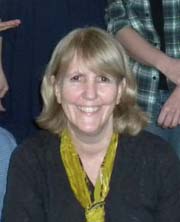
Janis Dickinson
Janis L. Dickinson, Professor Emerita, Natural Resources
Member of Graduate Fields:
Natural Resources & Neurobiology and Behavior
I am not taking any more grad students and I have moved back to California - best of luck with your search!
Postdocs: I strongly suggest that you seek out alternative mentors for the Cornell Lab's postdoctoral positions and wish you the best of luck with your application.
Lab News:
November 2019: New citizen science research paper:
Dickinson, J.L. and R.L. Crain. 2019. An experimental study of learning in an online citizen science project: Insights into study design and waitlist controls. Citizen Science: Theory and Practice. 4(1) 26, 1-13
May 2018: New mistletoe paper:
Koenig, W.D, Knops, J.M.H., Carmen, W.J., Pesendorfer, M.B., and Dickinson, J.L. 2018. Effects of mistletoe on California oaks. Biology Letters. 14: 20180240, https://dx.doi.org/10.6084/m9.figshare.c.4102142.
1 Jan 2018: On this day I retired from Cornell University and became Professor Emerita - Woo Hoo!
3 November 2017: Hwanseok Song published a new paper in Group Processes and Intergroup Relations:
Song, H., Schuldt, J. P., McLeod, P. L., Crain, R. L., & Dickinson, J. L. (2018). Group norm violations in an online environmental social network: Effects on impression formation and intergroup judgments . Group Processes & Intergroup Relations 21: 422-437. https://doi.org/10.1177/1368430217733118
21 February 2017: Maria Smith has published the lead article in the new issue of Behavioral Ecology and Sociobiology:
Smith, M.G., Dickinson, J.L., Rush, A.G., Wade, A.L., and D.-S. Yang. 2017. Western bluebird parents preferentially feed hungrier nestlings in a design that balances location in the nest. Behavioral Ecology and Sociobiology 71: 1-7.
20 February 2017: Prof. Hiromi Kobori's paper on citizen science, published in Ecological Research, was selected for an Outstanding Paper Award, 2016.
Kobori, H., Dickinson, J.L., Washitani, I., Sakurai, R., Amano, T., Komatsu, N., Kitamura, W., Takagawa, S., Koyama, K., Ogawara, T., and A. Miller-Rushing. 2016. Citizen science: A new approach to advance ecology, education, and conservation. Ecological Research 31: 1-19. DOI 10.1007/s11284-015-1314-y
19 Oct 2016: New paper co-authored by 4 professors from 3 departments at Cornell (thanks to the Cornell National Social Survey)
Dickinson, J.L., McLeod, P., Bloomfield, R., and S. Allred. 2016. Which moral foundations predict willingness to make lifestyle changes to avert climate change in the USA? PlosONE doi.org/10.1371/journal.pone.0163852.
15 Aug 2016: New western bluebird paper with Çaglar Akçay as first author
Akçay, C., Arnold, J.A., Hambury, K.L. and J.L. Dickinson. 2016. Age discrimination of rival males in western bluebirds. Animal Cognition 19: 999-1006, doi: 10.1007/s10071-016-1004-3.
1 July 2016: Congratulations to David Bonter
On July 1, David Bonter took over as the new Arthur Allen Director of Citizen Science at the Cornell Lab. My new lab title is 'Professor of Citizen Science.' I work from Hastings Reserve, UC Berkeley's field station in Carmel Valley, CA and now direct only the YardMap/Habitat Network collaboration with The Nature Conservancy and my long-term research on western bluebirds.
15 June 2016: Taza Schaming defends her thesis for the Ph.D. in Natural Resources (Wildlife Ecology)
Taza's family arrived in Ithaca for her defense in which she gave a wonderful talk to the DNR audience and folks from the Lab of Ornithology. Congratulations Taza!
31 May 2016: Kristin Hook defends her thesis for the Ph.D. in Neurobiology and Behavior (Behavioral Biology)
Kristin gave a great talk on sperm competition in the seed beetle, Callosobruchus maculatus,
28 May 2016: New bluebird paper with Megan Milligan as first author!
Megan Milligan is the first spring intern in 33 years to write a paper during the field season (and publish it within a year). Congratulations, Megan! Millgian, M. and J.L. Dickinson. 2016. Habitat Quality and Nest-box occupancy by five species of oak woodland birds. The AUK: Ornithological Advances 123: 429-438.
27 May 2016: Maria Smith and David Weber after receiving honors recognition in the Call Auditorium.
Today, Maria Smith (western bluebirds) and David Weber (acorn woodpeckers), were recognized in a special ceremony in Call auditorium and then again, in the ceremony for biological sciences majors. Congratulations, guys!

26 May 2016: Jake Blessing defends M.S. thesis
Today, Jake Blessing defended his M.S. thesis remotely from Monte Verde, Costa Rica. The defense was proctored at Jake's end by Frank Joyce, a Cornell Ph.D. who works for the University of California, and resides in Monte Verde. Anurag Agrawal and I examined Jake from Fernow Hall. The whole thing was over and done in just a little over an hour with Jake earning a clear pass. Congratulations, Jake - Walt and I will have a remote champagne toast to you this evening! The title of Jake's thesis is, "Costs and benefits of alternative egg-laying strategies in the milkweed leaf beetle, Labidomera clivicollis (Coleoptera: Chrysomelidae)."
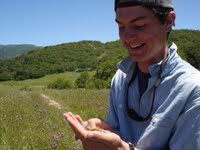
25 May 2016: Maria Smith honored at Merrill Presidential Scholar's luncheon
Today, Maria Smith took her place among a small number of Merrill Presidential Scholars here at Cornell, an award given only to the most outstanding seniors. She was honored at a luncheon in Willard Straight. The program allowed students to invite one professor and one high school teacher. Maria's high school research mentor, Charles Ashcraft, joined us. The students spoke eloquently about what mattered to them as they began to develop as scholars and how important mentoring is. Hearing this from some of our most successful students was a great reminder of how much the human side of education matters.
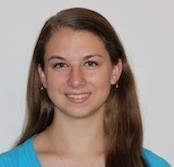
23 March 2016: Esther Niemasik Defends Thesis
Today Esther gave an outstanding talk on Brown-headed Nuthatches: "Cooperative breeding enables Brown-headed Nuthatches to overcome heterospecific competition pressure." Here is Esther with her committee (me, Kern Reeve, Tom Seeley, and Walter Koenig). Congratulations, Esther!"
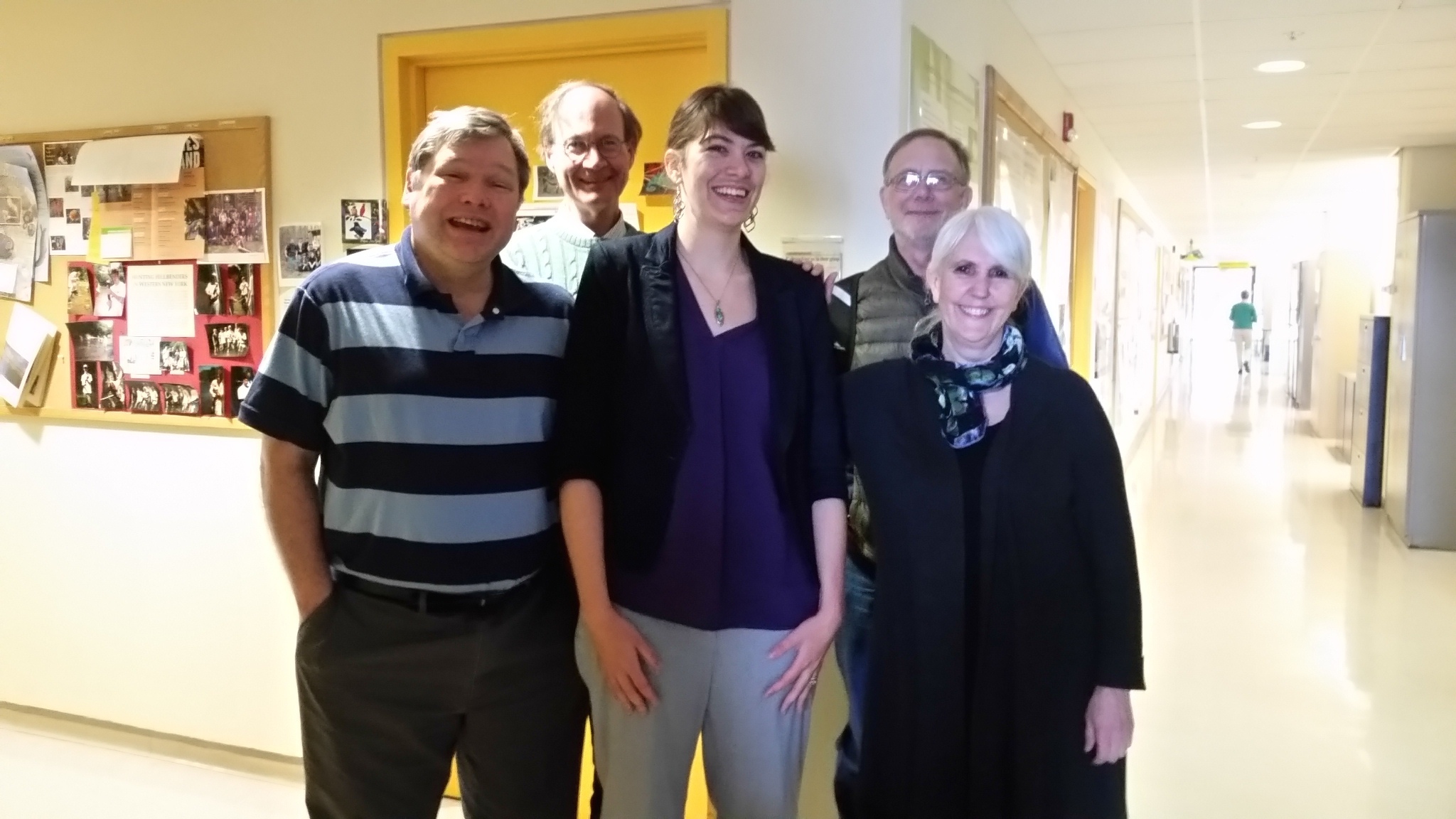
Left to right: K. Reeve, T. Seeley, E. Niemasik, W. Koenig, J. Dickinson Photo by S. Anderson
New paper for Caitlin Stern (Ph.D. 2012):
Caitlin's new model paper out in Behavioral Ecology: Stern, C.A. and J.L. Dickinson. 2016. Effects of load-lightening and delayed extrapair benefits on the fitness consequences of helping behavior. Behavioral Ecology doi: 10.1093/beheco/arw018
Congratulations, Caitlin!
Welcome new field volunteer, Amanda Werrell:
Amanda Werrell arrived at Hastings Reserve 1 Mar 2016 to begin a study of interspecific competition for nest sites between western bluebirds and oak titmice. Amanda earned her B.S. in Biology with the highest honors from Middlebury College in 2015 and wants to pursue a career in ornithology. Welcome, Amanda!
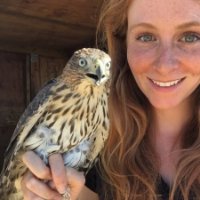
********
Fall 2012 Graduate Course:
The Evolution of Cooperation
BioNB/NTRes 6702
This is a graduate seminar on a cross-disciplinary topic of universal interest: how and why we cooperate! We will meet once per week for two hours and, together, we will cover a vast literature on cooperation, primarily among non-relatives, tapping empirical results on humans and other animals. This has been a very active area of research in the past decade and there are excellent reviews of many of our subtopics by Nowak, Fehr, Sigmund, Griskevicius, Boyd, Christakis, Ostrom, Rankin, Rilling, Cialdini, Keltner, and others, including faculty situated in various departments at Cornell. We will focus on proximate and ultimate aspects of cooperation, centering on the question of how collective action can be maintained in cases where individual self-interest counters group interests. This situation, usually referred to as a social dilemma, is particularly apparent with public goods, which are both nonexcludable, meaning everyone has access, and non-rivalrous, meaning one person’s use doesn’t appreciably deplete the resource for use by others. Public goods problems are broadly applicable to real-life issues, including use of natural resources and behavioral responses to communal problems like climate change. We consider the possibility that improved understanding of proximate mechanisms can shed light on how best to provide support for pro-environmental behavior for the benefit of current and future generations. The literature is vast, complicated, and exciting with new ideas, models, and findings appearing at a rapid rate even today!
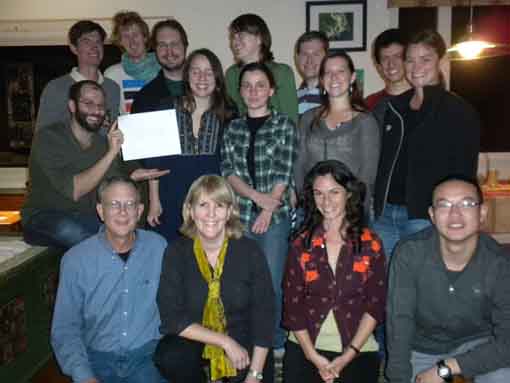
Hastings Reserve!
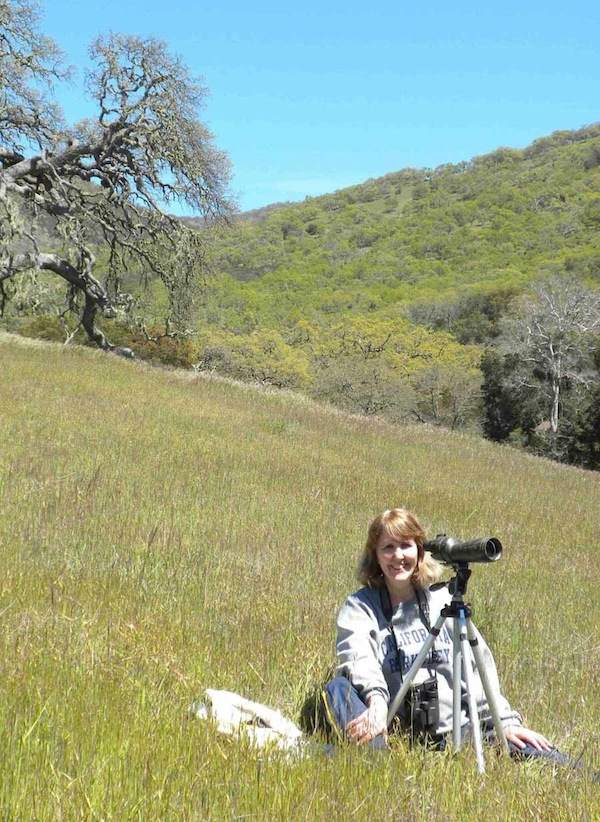
April 2011 at Hastings Reserve, Carmel Valley, CA Photo by J. Dickinson
Background:
I have been a faculty member in Natural Resources and Director of Citizen Science at Cornell Lab of Ornithology since fall of 2005. In Citizen Science, we are developing research models that involve a blend of citizen research participation over a broad spatial scale with studies to understand the potential for the internet to create conservation communities by providing support for human cooperation, particularly with regard to issues of sustainability and conservation of biodiversity. These activities coincide with my historic interests in cooperative breeding and other forms of social behavior at both proximate and ultimate levels of analysis and expand on these interests to include integration of such broad topics as existential- environmental psychology, social networking, and collective action theory. This breadth of interests requires involvement of a diverse team of researchers, graduate students, and undergraduates. Our ecological work focuses on anthropogenic change and its consequences for biodiversity. We emphasize behavioral variation, landscape change, spatial genetics, and climate change. Citizen science projects in my program include NestWatch, a national database for collecting new and historic nesting observations for North American birds, The YardMap Network, a project that uses citizen science and social networking to engage participants in learning about, practicing, and inventing new sustainable practices in residential landscapes, Project FeederWatch, which we used to study range limits for wintering birds, and Celebrate Urban Birds, which focuses on bringing nature and science to urban, underserved audiences.
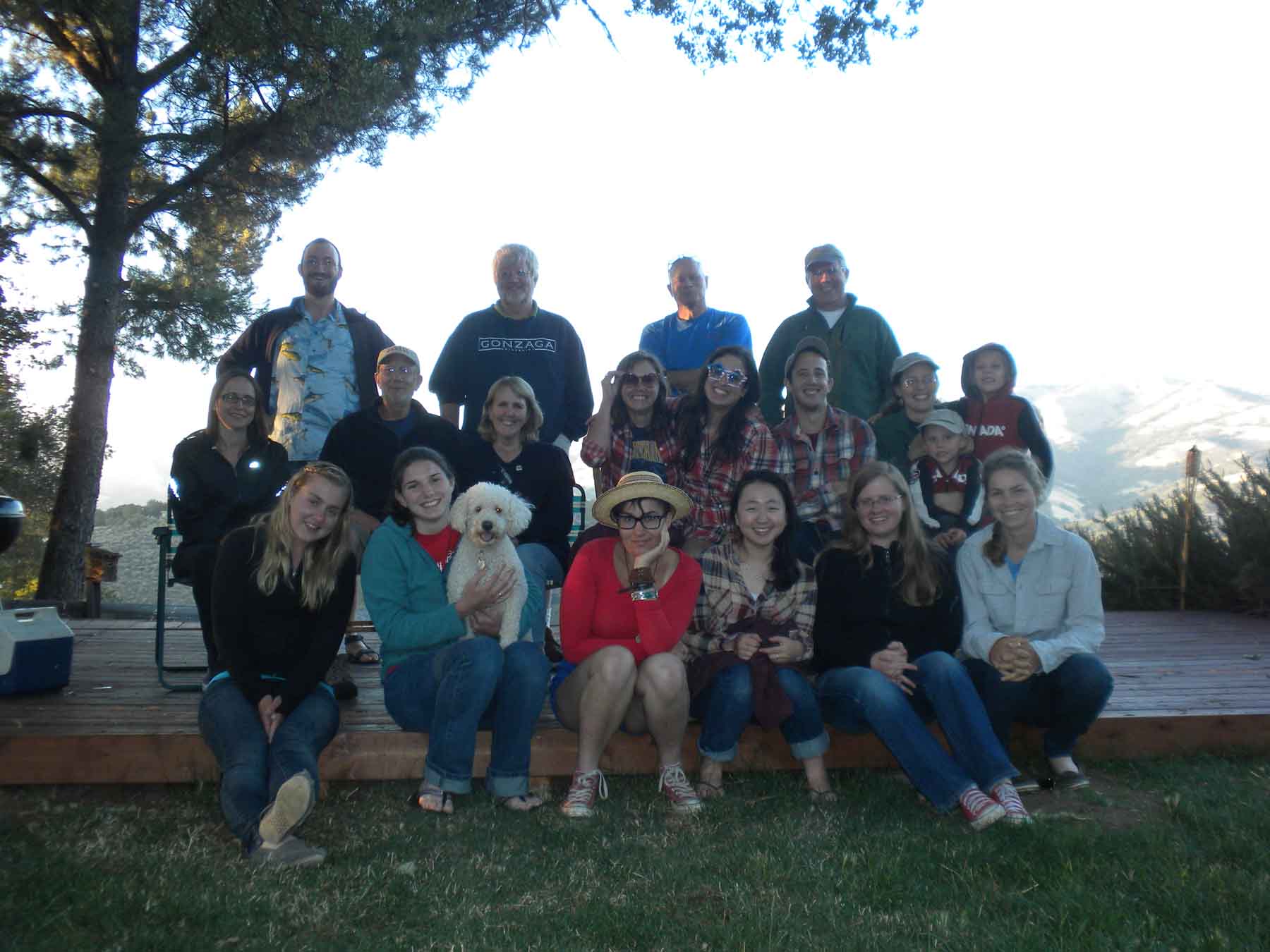
2012 Field crew at Hastings Reserve, Carmel Valley, CA Photo by J. Dickinson
My ongoing research program at Hastings Reserve involves using a long-term study of color-banded western bluebirds as a model system for testing key hypotheses regarding the evolution of mating systems, sex ratio, dispersal behavior, cooperative breeding, migration, and life history traits. At Hastings Reserve, mistletoe grows on deciduous oaks and produces a sustained berry crop over the winter. It appears to be a form of wealth that drives family group living. Although sons typically winter on their natal territories with their parents and sometimes become nonbreeding helpers, reducing mistletoe wealth by half causes sons to leave home. For the past five years, the western bluebird project has been directed at understanding bluebird-mistletoe interactions and testing the relative importance of territory quality and nepotism for keeping sons at home. This work incorporates field experiments and combines demographic analysis with GIS landscape modeling. We have now embarked on an investigation, led by postdoc Caglar Akcay, of kin recognition using vocal signals.
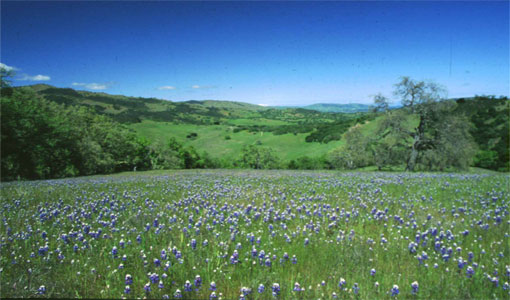
Hastings Reserve, Carmel Valley, CA Photo by David Gubernick
Curriculum Vitae - click here for ...
Publications - click here for ...
Media Links
-
Nature Podcast on Personality Profiles - http://www.nature.com/nature/podcast/v442/n7105/
nature-2006-08-24.mp3 - BBC “The Rules of Life” with Aubrey Manning, Programme 5 “Happy Families” - http://www.bbc.co.uk/radio4/
science/rulesoflife.shtml - National Geographic News - http://news.nationalgeographic.com/
- Great Backyard Bird Count - Http://www.npr.org/templates/story/
story.php?storyId=5221793 - Cornell - http://www.news.cornell.edu/stories/April06/
LabTaskForce.ksr.html
See www.rainbowspirit.com for more images of the Hastings Reserve
Contact Information
Janis L. Dickinson
Cornell Lab of Ornithology
159 Sapsucker Rd,
Ithaca, NY 14850
Office: 607 - 254-2194
jld84@cornell.edu
My office in Fernow Hall (Tue. afternoons only): Rm. 102A
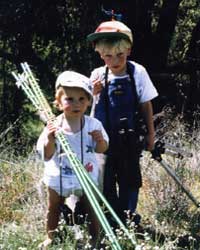
Phoebe and Dale Koenig studying birds at Hastings Reserve in 1994
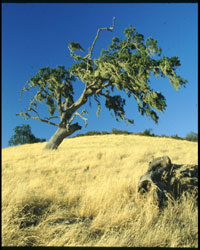
Oak with Mistletoe. Photos ©David J. Gubernick